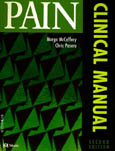Pain: Clinical Manual (Second Edition)
Authors: Margo McCaffery, RN, MS, FAAN, and Chris Pasero, RN, MSNc OncoLink Rating: |
Medical texts often overlook the treatment of pain as a vital issue to the treatment of patients. McCaffery and Pasero hope to change that, believing that the treatment of pain is as important as treating the illness. These two editors both work actively as pain care specialists, by working with patients and by serving on numerous committees to further research and understanding of pain management. They state that "The purpose of this manual is to provide current, scientifically based, practical information for nurses, physicians, pharmacists, and others who must manage pain in patients they encounter in their daily practice." They brought together numerous contributors and reviewers, from all over America (and two from Canada), representing fields ranging from nurses and doctors to pain management specialists. They put together this excellent and informative manual.
The manual is exceptional in both content and style. Its content is noteworthy because it covers such a vast array of topics. The manual is divided into sixteen chapters, and the first chapter provides an overview of problems and progress made in the understanding of pain management. The manual then goes on to describe basic pain mechanisms that cause pain, making use of helpful diagrams to illustrate the anatomy and physiology of pain.
The manual dedicates four chapters to pharmacology, describing the drugs and how to use and combine them. An entire chapter is devoted to non-drug approaches to pain, such as relaxation, distraction, and superficial heating and cooling. This chapter even contains a section on non-drug approaches to pain management for children. There is a chapter on managing pain in the elderly, and a chapter on managing pain in patients with substance abuse problems.
The manual contains a chapter on the use of analgesics during pregnancy, delivery and thereafter, followed by a chapter on pain management in infants. The final chapter is entitled "Building Institutional Commitment to Improving Pain Management." It reflects the editors? belief that health care providers (such as nurses, doctors and pharmacists) must work together to understand and improve pain management. The manual concludes with several appendices in the back, one of which defines terms used in the text. It is followed by an index.
The manual covers an impressive list of topics, but equally noteworthy is its easy style. Each chapter begins with an outline, followed by a list of terms and definitions used in that chapter. Chapters end with a list of references, if applicable, so the reader has the option to do further research. The table of contents is very clear, making it simple to look up one?s topic of interest. The manual provides many lists and tables of information, which are all very well labeled. It also makes good use of figures.
This manual contains an incredible amount of information in a very easy to read manner. It is also very well organized. This book would benefit any health care professional, and could even be referenced by a layperson.


